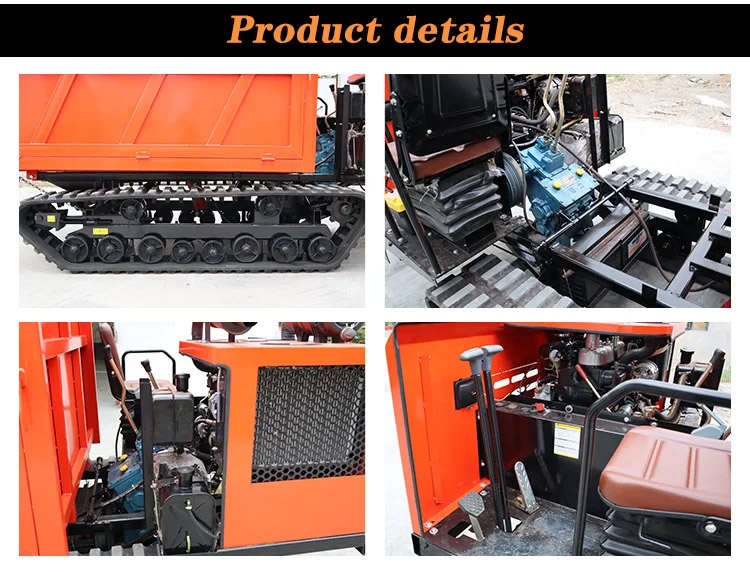- Home >
- Product >
- Loaders >
- Crawler Dumper >
- View Details
3T Crawler Dumper Professional quality
Versatile Attachments: Many tracked vehicles can be equipped with a variety of attachments and equipment, making them adaptable for numerous tasks. Attachments may include dozer blades, excavator arms, cranes, or cargo containers, enhancing their versatility.
- 3T
- ZHUOXIN
- Crawler Dumper
- shandong.china
- TT, Paypal, Credit card, Western union
- +86-15163766288
- Military Tanks: Military tanks are formidable tracked vehicles equipped with heavy armor and advanced weaponry. They are crucial assets in modern warfare, capable of dominating the battlefield.
Description

Tracked transport vehicles, often seen as the unsung heroes of industrial and military innovation, represent an intriguing fusion of history, engineering, and adaptability. These extraordinary machines, characterized by their continuous tracks, have transitioned from being formidable forces on the battlefield to becoming indispensable tools in construction and various industries. In this captivating exploration, we will uncover the captivating journey of tracked transport vehicles, from their origins to their diverse contemporary applications.

Historical Origins:
The concept of tracked vehicles can be traced back to the early 20th century when inventors and engineers were driven by the idea of creating machines capable of traversing challenging terrain. It was during World War I that the first military tanks, armed with tracks for enhanced mobility, emerged on the battlefield, revolutionizing modern warfare.

Key Developments:
Military Pioneers: Early tracked vehicles, like the British Mark I tank, showcased the potential of continuous tracks in warfare. These armored behemoths could overcome trenches and rough terrain, altering the course of battles.

Post-War Evolution: After World War I, tracked vehicles found new life in peacetime applications. Construction and agricultural industries recognized their potential for efficient earthmoving and improved mobility on farms.
Modern Advancements: Over the decades, technological advancements have transformed tracked transport vehicles. Modern military tanks are equipped with cutting-edge armor, firepower, and navigation systems, while construction equipment boasts GPS, telematics, and precision controls.

Diverse Contemporary Applications:
Tracked transport vehicles have evolved into a diverse range of types, each tailored to specific functions:
Military Titans: Modern tanks remain at the forefront of military operations, boasting unmatched firepower, protection, and strategic mobility.
Construction Giants: Tracked excavators, bulldozers, and cranes are the workhorses of construction sites, providing stability, power, and precision for earthmoving tasks.
Agricultural Workhorses: Tracked tractors and harvesters have revitalized agriculture, ensuring minimal soil compaction and maximum crop yields.
Cold-Weather Guardians: Snow groomers and snowcats maintain ski slopes and ensure safety in winter sports, enhancing the joy of snow enthusiasts.
Forest Masters: Tracked skidders and forwarders are indispensable in forestry, simplifying the extraction and transportation of timber from remote and rugged terrain.

Conclusion:
Tracked transport vehicles represent more than just machines; they embody a remarkable evolution in engineering and adaptability. From their origins as battlefield titans to their roles as earth-moving giants, these vehicles have showcased their versatility in a multitude of applications. Their history is a testament to human innovation, and their future holds promise as they continue to adapt to emerging challenges and push the boundaries of what's possible. In an ever-changing world, tracked transport vehicles stand as a symbol of resilience and evolution in the face of adversity.

Historical Origins:
The concept of tracked vehicles can be traced back to the early 20th century when inventors and engineers were driven by the idea of creating machines capable of traversing challenging terrain. It was during World War I that the first military tanks, armed with tracks for enhanced mobility, emerged on the battlefield, revolutionizing modern warfare.

Key Developments:
Military Pioneers: Early tracked vehicles, like the British Mark I tank, showcased the potential of continuous tracks in warfare. These armored behemoths could overcome trenches and rough terrain, altering the course of battles.

Post-War Evolution: After World War I, tracked vehicles found new life in peacetime applications. Construction and agricultural industries recognized their potential for efficient earthmoving and improved mobility on farms.
Modern Advancements: Over the decades, technological advancements have transformed tracked transport vehicles. Modern military tanks are equipped with cutting-edge armor, firepower, and navigation systems, while construction equipment boasts GPS, telematics, and precision controls.

Diverse Contemporary Applications:
Tracked transport vehicles have evolved into a diverse range of types, each tailored to specific functions:
Military Titans: Modern tanks remain at the forefront of military operations, boasting unmatched firepower, protection, and strategic mobility.
Construction Giants: Tracked excavators, bulldozers, and cranes are the workhorses of construction sites, providing stability, power, and precision for earthmoving tasks.
Agricultural Workhorses: Tracked tractors and harvesters have revitalized agriculture, ensuring minimal soil compaction and maximum crop yields.
Cold-Weather Guardians: Snow groomers and snowcats maintain ski slopes and ensure safety in winter sports, enhancing the joy of snow enthusiasts.
Forest Masters: Tracked skidders and forwarders are indispensable in forestry, simplifying the extraction and transportation of timber from remote and rugged terrain.

Conclusion:
Tracked transport vehicles represent more than just machines; they embody a remarkable evolution in engineering and adaptability. From their origins as battlefield titans to their roles as earth-moving giants, these vehicles have showcased their versatility in a multitude of applications. Their history is a testament to human innovation, and their future holds promise as they continue to adapt to emerging challenges and push the boundaries of what's possible. In an ever-changing world, tracked transport vehicles stand as a symbol of resilience and evolution in the face of adversity.
Tags
Get the latest price? We'll respond as soon as possible(within 12 hours)























